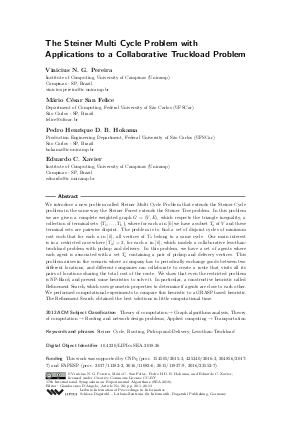The Steiner Multi Cycle Problem with Applications to a Collaborative Truckload Problem
Authors Vinicius N. G. Pereira, Mário César San Felice, Pedro Henrique D. B. Hokama, Eduardo C. Xavier
-
Part of:
Volume:
17th International Symposium on Experimental Algorithms (SEA 2018)
Part of: Series: Leibniz International Proceedings in Informatics (LIPIcs)
Part of: Conference: International Symposium on Experimental Algorithms (SEA) - License:
 Creative Commons Attribution 3.0 Unported license
Creative Commons Attribution 3.0 Unported license
- Publication Date: 2018-06-19
File

PDF
LIPIcs.SEA.2018.26.pdf
- Filesize: 0.55 MB
- 13 pages
Document Identifiers
Subject Classification
ACM Subject Classification
- Theory of computation → Graph algorithms analysis
- Theory of computation → Routing and network design problems
- Applied computing → Transportation
Keywords
- Steiner Cycle
- Routing
- Pickup-and-Delivery
- Less-than-Truckload
Metrics
- Access Statistics
-
Total Accesses (updated on a weekly basis)
0Document
0Metadata
Abstract
We introduce a new problem called Steiner Multi Cycle Problem that extends the Steiner Cycle problem in the same way the Steiner Forest extends the Steiner Tree problem. In this problem we are given a complete weighted graph G=(V,E), which respects the triangle inequality, a collection of terminal sets {T_1,..., T_k}, where for each a in [k] we have a subset T_a of V and these terminal sets are pairwise disjoint. The problem is to find a set of disjoint cycles of minimum cost such that for each a in [k], all vertices of T_a belong to a same cycle. Our main interest is in a restricted case where |T_a| = 2, for each a in [k], which models a collaborative less-than-truckload problem with pickup and delivery. In this problem, we have a set of agents where each agent is associated with a set T_a containing a pair of pickup and delivery vertices. This problem arises in the scenario where a company has to periodically exchange goods between two different locations, and different companies can collaborate to create a route that visits all its pairs of locations sharing the total cost of the route. We show that even the restricted problem is NP-Hard, and present some heuristics to solve it. In particular, a constructive heuristic called Refinement Search, which uses geometric properties to determine if agents are close to each other. We performed computational experiments to compare this heuristic to a GRASP based heuristic. The Refinement Search obtained the best solutions in little computational time.
Cite As Get BibTex
Vinicius N. G. Pereira, Mário César San Felice, Pedro Henrique D. B. Hokama, and Eduardo C. Xavier. The Steiner Multi Cycle Problem with Applications to a Collaborative Truckload Problem. In 17th International Symposium on Experimental Algorithms (SEA 2018). Leibniz International Proceedings in Informatics (LIPIcs), Volume 103, pp. 26:1-26:13, Schloss Dagstuhl – Leibniz-Zentrum für Informatik (2018)
https://doi.org/10.4230/LIPIcs.SEA.2018.26
BibTex
@InProceedings{pereira_et_al:LIPIcs.SEA.2018.26,
author = {Pereira, Vinicius N. G. and San Felice, M\'{a}rio C\'{e}sar and Hokama, Pedro Henrique D. B. and Xavier, Eduardo C.},
title = {{The Steiner Multi Cycle Problem with Applications to a Collaborative Truckload Problem}},
booktitle = {17th International Symposium on Experimental Algorithms (SEA 2018)},
pages = {26:1--26:13},
series = {Leibniz International Proceedings in Informatics (LIPIcs)},
ISBN = {978-3-95977-070-5},
ISSN = {1868-8969},
year = {2018},
volume = {103},
editor = {D'Angelo, Gianlorenzo},
publisher = {Schloss Dagstuhl -- Leibniz-Zentrum f{\"u}r Informatik},
address = {Dagstuhl, Germany},
URL = {https://drops.dagstuhl.de/entities/document/10.4230/LIPIcs.SEA.2018.26},
URN = {urn:nbn:de:0030-drops-89617},
doi = {10.4230/LIPIcs.SEA.2018.26},
annote = {Keywords: Steiner Cycle, Routing, Pickup-and-Delivery, Less-than-Truckload}
}
Author Details
- Institute of Computing, University of Campinas (Unicamp), Campinas - SP, Brazil
- Department of Computing, Federal University of São Carlos (UFSCar), São Carlos - SP, Brazil
- Production Engineering Department, Federal University of São Carlos (UFSCar), São Carlos - SP, Brazil
Funding
This work was supported by CNPq (proc. 154505/2015-3, 425340/2016-3, 304856/2017-7) and FAPESP (proc. 2017/11382-2, 2016/11082-6, 2015/11937-9, 2016/23552-7).
References
-
Jose Caceres-Cruz, Pol Arias, Daniel Guimarans, Daniel Riera, and Angel A Juan. Rich vehicle routing problem: Survey. ACM Computing Surveys (CSUR), 47(2):32, 2015.

-
William J Cook, WH Cunningham, WR Pulleyblank, and A Schrijver. Combinatorial optimization. Springer, 2009.

-
Elizabeth D Dolan and Jorge J Moré. Benchmarking optimization software with performance profiles. Mathematical programming, 91(2):201-213, 2002.

-
Özlem Ergun, Gültekin Kuyzu, and Martin W. P. Savelsbergh. Reducing truckload transportation costs through collaboration. Transportation Science, 41(2):206-221, 2007.

-
Özlem Ergun, Gültekin Kuyzu, and Martin W. P. Savelsbergh. Shipper collaboration. Computers & OR, 34(6):1551-1560, 2007.

-
Thomas A Feo and Mauricio GC Resende. A probabilistic heuristic for a computationally difficult set covering problem. Operations research letters, 8(2):67-71, 1989.

-
Michel X. Goemans and David P. Williamson. A general approximation technique for constrained forest problems. SIAM J. Comput., 24(2):296-317, 1995.

-
Ralph E Gomory and Tien Chung Hu. Multi-terminal network flows. Journal of the Society for Industrial and Applied Mathematics, 9(4):551-570, 1961.

-
Martin Grötschel, László Lovász, and Alexander Schrijver. The ellipsoid method and its consequences in combinatorial optimization. Combinatorica, 1(2):169-197, 1981.

- Gurobi Optimization, Inc. Gurobi optimizer reference manual, 2016. URL: http://www.gurobi.com.
-
Dan Gusfield. Very simple methods for all pairs network flow analysis. SIAM Journal on Computing, 19(1):143-155, 1990.

-
Hipólito Hernández-Pérez and Juan-José Salazar-González. The multi-commodity one-to-one pickup-and-delivery traveling salesman problem. European Journal of Operational Research, 196(3):987-995, 2009.

-
Ismail Karaoglan, Fulya Altiparmak, Imdat Kara, and Berna Dengiz. The location-routing problem with simultaneous pickup and delivery: Formulations and a heuristic approach. Omega, 40(4):465-477, 2012.

- Lemon. Library for efficient modeling and optimization in networks, 2016. URL: http://lemon.cs.elte.hu/trac/lemon/.
- LOCo - UNICAMP. Laboratory of optimization and combinatorics, 2016. URL: http://www.loco.ic.unicamp.br.
-
Sophie N. Parragh, Karl F. Doerner, and Richard F. Hartl. A survey on pickup and delivery problems. Journal für Betriebswirtschaft, 58(1):21-51, 2008.

-
Mauricio GC Resende and Celso C Ribeiro. Optimization by GRASP: Greedy Randomized Adaptive Search Procedures. Springer, 2016.

-
Juan-José Salazar-González. The Steiner cycle polytope. European Journal of Operational Research, 147(3):671-679, 2003.

-
Monika Steinová. Approximability of the minimum Steiner cycle problem. Computing and Informatics, 29(6+):1349-1357, 2012.

-
Paolo Toth and Daniele Vigo. Vehicle routing: problems, methods, and applications, volume 18. Siam, 2014.

